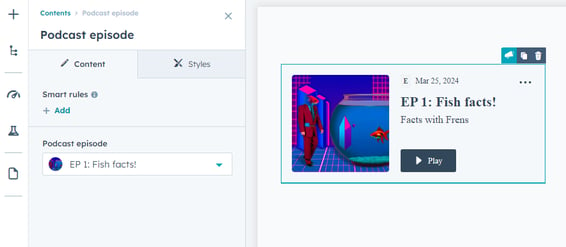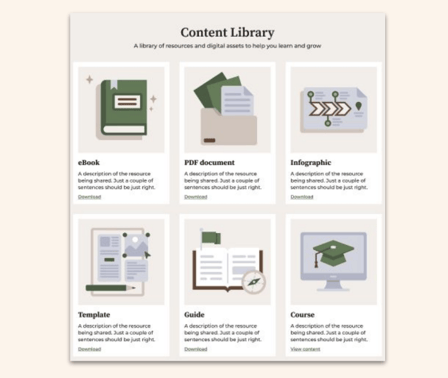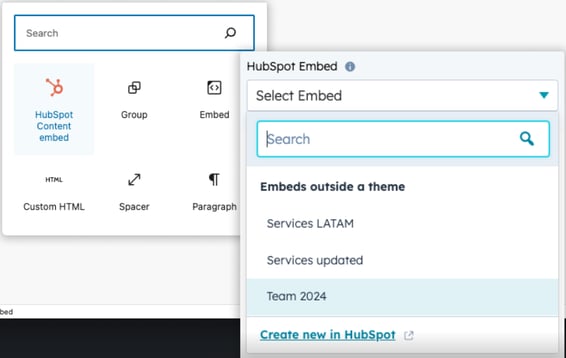





In this blog post, we will take a close look at what HubSpot's Content Hub offers, breaking down its key features, and new updates, and how it compares to the former CMS Hub. Essentially, we're exploring how this platform could change the game for businesses looking to get their content out there, make it look good, and reach the right people.
What is a Content Hub?
On April 3rd 2024, in an effort to evolve their current CMS Hub HubSpot released the Content Hub.
Now what exactly is a content hub?
Content Hub is an efficient AI-powered tool designed to make life easier for content marketers. It helps you create and manage engaging, personalised content that really clicks with your audience, from the first click to the final conversion. Think of it as a centralised platform for keeping all your content assets in order, making sure your team stays on the same page with your content strategy.
In simpler words, it’s a revised version of the former CMS Hub clubbed along with a few Marketing Hub features.
With Content Hub, you can boost your revenue with content that engages your customers and drives more revenue by using AI to tweak your content for different channels, saving a ton of time by having everything content-related in one place. It's an essential tool for businesses aiming to enhance their content effectiveness while maintaining professionalism and efficiency in their operations.
Why do you need a Content Hub?
Content is everywhere. And, consequently, so are content marketers.
Increasing competition. Changing consumption patterns. Influx of content.
All this has made it important to keep up with creating lots of different kinds of content and sharing it in various places online to grab people's attention. The problem is, that it can get pretty tough, especially when you're trying to do more and drive revenue without adding more people to your team. Plus, figuring out what really gets your audience interested and managing all that content across different platforms isn't easy.
That's where Content Hub steps in.
Previously, CMS Hub got its due popularity because it helped businesses create websites that could really connect with visitors, thanks to its smart use of customer data creating CRM-powered websites. But as times changed, just having a blog or a website wasn't enough. People started wanting content in all sorts of formats and on more platforms than ever before.
HubSpot saw this change and knew they had to come up with something new. So, they introduced Content Hub. Think of Content Hub as the next step up from CMS Hub. It's designed to make it easier to create all kinds of content (like videos, podcasts, and more) and manage it all in one place. No more juggling different tools or losing track of whether your content is hitting the mark.
The idea behind launching Content Hub was pretty straightforward. HubSpot wanted to clear up any confusion about what their platform could do, especially since "CMS" sounded too techy and limited to just websites. They wanted everyone to know that their platform was about handling all sorts of content, not just web pages. So, Content Hub is all about being your one-stop shop for everything content-related, making it simpler to keep everything organised and making sure it resonates with your audience.
In short, Content Hub is here to make life easier for those who are in charge of getting their brand's message out there, in whatever form that might be. It's about keeping up with the digital world's demands and making sure your content game is strong, without the extra headache.
Content Hub VS CMS Hub: What's the Difference?
If CMS Hub was your basic toolkit for building and managing a website, think of Content Hub as an upgraded version of this toolkit that comes with all the CMS Hub features along with some Marketing Hub features and a couple of new features as well.
For starters, if you're already using CMS Hub, you'll get some new features without having to do anything. These include things like a gated content library (where you can put content behind a form to capture leads), gated blogs, a basic blog post generator, an AI website builder, AI image generation, and blog post narration.
However, Content Hub has exclusive features that you won't find in CMS Hub, such as content remixing (which lets you tweak and repurpose your content in new ways), a feature to maintain your brand voice consistently across all content, the ability to easily integrate podcasts, embed other content types seamlessly, translate your content with AI for different audiences, and a custom blog post generator that gives you more control and personalisation options.
With Content Hub, you get access to the latest features that are specifically designed to help you create, manage, and optimise your content in more advanced and personalised ways.
What's New in Content Hub?
We briefly mentioned earlier that the Content Hub came with some new features that weren’t previously available on CMS Hub. Let’s take a look at these features:
Content Remix
.webp?width=414&height=263&name=Content%20remix%204%20(1).webp)
Source: Content Remix, HubSpot
Ever felt overwhelmed about getting your content out there in different ways? We’ve all been there.
You know how it goes - you spend ages creating something cool, like a podcast episode or a blog post, and then the thought of chopping it up and sharing it everywhere just feels like too much work.
Well, Content Remix certainly makes the job easy. In just a few clicks, you can turn that one piece of content into social media posts, ads, landing pages, and even audio snippets or images. Easily repurpose your content on different platforms without the extra headache.
Podcast Hosting
 Source: Use Podcasts, HubSpot Knowledge Base
Source: Use Podcasts, HubSpot Knowledge Base
This feature makes it easy for you to jump into the world of podcasting directly from HubSpot and reach out to folks who love consuming audio content, expanding your audience in a whole new direction.
With the help of AI tools, the time and effort needed to produce audio content get slashed significantly. You can either upload your own audio files or let the AI do its magic and generate audio for you.
The idea of having everything in one place definitely makes it sound convenient. And when you throw in the Blog Post AI Narration feature, it feels like we could be looking at a much smoother process for getting our content out there in different formats.
Content Library
 Source: Content Hub Overview, Seismic
Source: Content Hub Overview, Seismic
The Content Library is a pre-packaged module that lets you build out content resource pages easily, offering loads of customisation options to make sure everything fits your style. Think of it as an upgraded version of the Files feature, with additional features like managing who gets to see certain pieces of content.
This step towards a broader content management strategy means you can have all your valuable resources in one spot, making it easy for both prospects and existing customers to find what they need. You can even enable VIP-exclusive content by requiring visitors to log in to access premium digital assets like audio clips, videos, PDFs, and more. This not only streamlines how people access your content but also drives engagement by adding that exclusive touch.
Content Embed
 Source: Embed Content in HubSpot & WordPress, HubSpot Knowledge Base
Source: Embed Content in HubSpot & WordPress, HubSpot Knowledge Base
The Content Embed feature lets you easily create and update content for your WordPress site right from HubSpot, no coding is needed. It works smoothly with WordPress editor, so adding fresh content is a breeze. Plus, you can use HubSpot's data to make this content personalised for your visitors, even when it's on your WordPress site. Change something once in HubSpot, and it updates everywhere automatically. It's a simple way to keep your site personalised and up-to-date without extra hassle.







